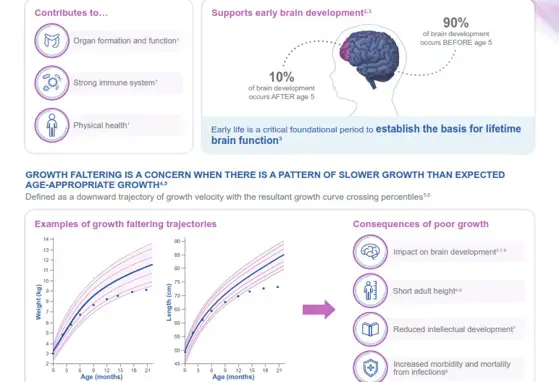[Guideline summary] Dietary guidelines for Americans 2020-2025
![[Guideline summary] Dietary guidelines for Americans 2020-2025](/sites/default/files/styles/header_image_article_mobile/public/2021-01/202_variety%20of%20food.jpg.webp?itok=n5Niz3XW)
The newly released dietary guidelines from the U.S. Departments of Agriculture (USDA) and Health and Human Services (HHS) offers guidance for all stages of the life span. For the first time since the 1985 edition, it now includes recommendations for infants and toddlers, as well as continuing the emphasis on healthy dietary patterns during pregnancy and lactation.
Key Recommendations:
-
Follow a healthy dietary pattern
- Focus on meeting food group needs with nutrient-dense foods and beverages, while staying within caloric limits
- The core elements that make up a healthy dietary pattern:
- Vegetables, including beans, peas, and lentils; starchy; and other vegetables
- Fruits, especially whole fruits
- Grains, at least half of which are whole grain
- Dairy, including fat-free or low-fat milk, yogurt, and cheese, and/or lactose-free versions of above; and fortified soy alternatives
- Protein foods, including lean meats, poultry and eggs; seafood; beans, peas, and lentils; and nuts, seeds, and soy products
- Oils, including vegetable oils and oils in food, such as seafood and nuts
- Limit foods and beverages higher in added sugars, saturated fat, and sodium, and limit alcoholic beverages
- Specified limits are:
- Added ≤ 10% daily caloric intake starting at two years old. Avoid foods and beverages with added sugars for those younger than two
- Saturated fat ≤ 10% daily caloric intake starting at two years old
- Sodium ≤ 2,300mg per day, and even less for children younger than 14 years old
- Alcoholic beverages = Adults of legal drinking age can choose not to drink, or to drink in moderation by limiting intake ≤ two drinks in a day for men and ≤ one drink in a day for women, when alcohol is consumed
- Specified limits are:
-
For infants, toddlers and young children (New)
- Exclusively breastfeed infants for about the first 6 months of life
- Continue to feed infants human milk through at least the first year of life and longer if desired
- When breastfeeding is unavailable, feed infants iron-fortified infant formula during the first year of life
- Supplement infants with vitamin D beginning soon after birth
- All infants who are fed human milk exclusively or who receive both human milk and infant formula (mixed fed) will need a vitamin D supplement of 400 IU per day
- Achieving adequate vitamin D from natural dietary sources alone is challenging, hereby suggesting that young children may need to vitamin D supplementation after age 12 months
- At about 6 months, introduce nutrient-dense complementary foods
- Introduce potentially allergenic foods along with other complementary foods
- Encourage consumption of a variety of foods from all food groups, in particular foods rich in iron and zinc, which are especially important for breastfed infants
- From 12 months through to older adulthood, follow a healthy dietary pattern across the lifespan to meet nutrient needs, help achieve a healthy body weight, and reduce the risk of chronic diseases
- Exclusively breastfeed infants for about the first 6 months of life
-
For pregnant and lactating women
- Increased calorie and nutrient needs should be met with nutrient-dense foods instead of with foods high in added sugars, saturated fat, and sodium
- There is no need to restrict food choices during pregnancy or lactation to prevent food allergy from developing in their child. However, women who are pregnant should pay attention to some important food safety considerations
- Foods containing seafood, meats, poultry, or eggs should be cooked to recommended safe minimum internal temperatures. Special precautions are needed to avoid consumption of unpasteurized (raw) juice or milk, raw sprouts, or some soft cheeses made from unpasteurized milk
- Most healthcare providers recommend women who are pregnant or planning pregnancy to take a daily prenatal vitamin and mineral supplement in addition to consuming a healthy dietary pattern. This may be especially important to meet increased folate/folic acid, iron, iodine, and vitamin D needs
- Seek guidance from a healthcare provider on appropriate use of prenatal or other dietary supplements during lactation
- Healthy pregnant women without contraindications and women postpartum should aim for at least 150 minutes of moderate-intensity aerobic activity a week, as they are able
Link to publication: https://www.dietaryguidelines.gov/sites/default/files/2020-12/Dietary_Guidelines_for_Americans_2020-2025.pdf
Reference
U.S. Department of Agriculture and U.S. Department of Health and Human Services. Dietary Guidelines for Americans, 2020-2025. 9th Edition. 2020.
Other articles that you might be interested in:
WNSC Hong Kong Info Card – Vitamin D Fact Sheet
WYE-EM-014-JAN-21
If you liked this post you may also like


Infographic - Can Growing-Up Milk Help Boost the Child's Key Nutrients for Growth and development?

The Learning Lead - Volume 2, 2024: "Can Growing-Up Milk Help Boost The Child’s Key Nutrients for Growth and Development?"
